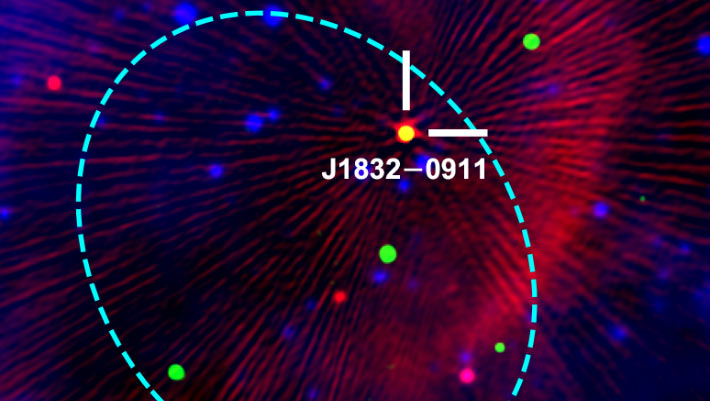ASKAP J1832-0911 — likely a magnetar or an extremely magnetized white dwarf — emits pulses of radio waves and X-rays for two minutes every 44 minutes, according to a paper published in the journal Nature.
A composite of radio, X-ray, and infrared emission of the field of ASKAP J1832-0911. Image credit: Wang et al., doi: 10.1038/s41586-025-09077-w.
ASKAP J1832-0911 is located approximately 15,000 light-years away from Earth in the constellation of Scutum.
The star was discovered by astronomers using the ASKAP radio telescope in Australia.
It belongs to a class of objects called long-period radio transients, first spotted in 2022, that vary in radio wave intensity in a regular way over tens of minutes.
This is thousands of times longer than the length of the repeated variations seen in pulsars, which are rapidly spinning neutron stars that have repeated variations multiple times a second.
“ASKAP J1832-0911 cycles in radio wave intensity every 44 minutes, placing it into this category of long-period radio transients,” said Dr. Ziteng Wang, an astronomer with the Curtin University node at the International Centre for Radio Astronomy Research (ICRAR), and colleagues.
Using NASA’s Chandra X-ray Observatory, the researchers discovered that ASKAP J1832 is also regularly varying in X-rays every 44 minutes.
This is the first time that such an X-ray signal has been found in a long-period radio transient.
“Astronomers have looked at countless stars with all kinds of telescopes and we’ve never seen one that acts this way,” Dr. Wang said.
“It’s thrilling to see a new type of behavior for stars.”
Using Chandra and the SKA Pathfinder, the scientists found that ASKAP J1832-0911 also dropped off in X-rays and radio waves dramatically over the course of six months.
This combination of the 44-minute cycle in X-rays and radio waves in addition to the months-long changes is unlike anything astronomers have seen in the Milky Way Galaxy.
The authors are now racing to figure out if ASKAP J1832-0911 is representative of long-period radio transients and whether its bizarre behavior helps unravel the origin of these objects.
“We looked at several different possibilities involving neutron stars and white dwarfs, either in isolation or with companion stars,” said Dr. Nanda Rea, an astronomer at the Institute of Space Sciences in Barcelona, Spain.
“So far nothing exactly matches up, but some ideas work better than others.”
ASKAP J1832-0911 is unlikely to be a pulsar or a neutron star pulling material from a companion star because its properties do not match the typical intensities of radio and X-ray signals of those objects.
Some of the object’s properties could be explained by a neutron star with an extremely strong magnetic field, called a magnetar, with an age of more than 500,000 years.
However, its other features, such as its bright and variable radio emission, are difficult to explain for such a relatively old magnetar.
On the sky, ASKAP J1832-0911 appears to lie within a supernova remnant, which often contains a neutron star formed by the supernova.
However, the team determined that the proximity is probably a coincidence and the two are not associated with each other, encouraging them to consider the possibility that it does not contain a neutron star.
They concluded that an isolated white dwarf does not explain the data but that a white dwarf star with a companion star might.
However, it would require the strongest magnetic field ever known for a white dwarf in our Galaxy.
“We will continue to hunt for clues about what is happening with this object, and we’ll look for similar objects,” said Dr. Tong Bao, an astronomer at the Italian National Institute for Astrophysics (INAF) — Osservatorio Astronomico di Brera.
“Finding a mystery like this isn’t frustrating — it’s what makes science exciting!”
_____
Z. Wang et al. Detection of X-ray emission from a bright long-period radio transient. Nature, published online May 28, 2025; doi: 10.1038/s41586-025-09077-w

























